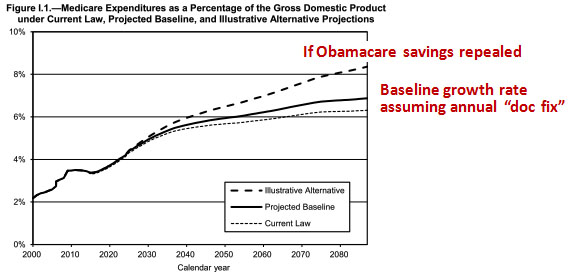Jason Millman sums up the Medicare trustees’ report:
This year’s verdict: Medicare’s hospital insurance trust fund will be solvent through 2030, which gives the program four more years of solvency than projected in the trustees’ 2013 report. It’s also 13 years later than the prediction issued by the trustees just before passage of the Affordable Care Act in 2010.
Margot Sanger-Katz wonders how long the good news will continue:
Medicare’s trustees acknowledged that the spending slowdown driving their improved forecasts was still mysterious, and that its durability couldn’t be counted on. They are not alone in that view: There’s a healthy debate among academics and health care policy experts about why health spending has slowed recently. “No one knows” what’s causing the slowdown, said Charles Blahous III, the lone Republican among the trustees, at a news conference announcing the findings. Robert Reischauer, another public trustee, agreed that scholars were “many years away” from understanding the slowdown’s precise causes, though he was more optimistic that the slowdown could stick.
Drum posts the above chart:
Medicare actuaries take the efficiency measures in Obamacare pretty seriously. If we stick to them, they really are likely to cut the growth rate of Medicare spending. And remember: Medicare costs get reflected in overall health care costs too. If Republicans ever win their jihad against Obamacare, we lose not just the Medicare savings, but a lot of savings in private health care too. That’s a lot to give up.
Philip Klein is skeptical those savings will materialize:
“The Affordable Care Act is making important changes to the Medicare program that are designed, in part, to substantially improve its financial outlook,” [Paul Spitalnic, the chief actuary for the Centers for Medicare and Medicaid Services] wrote. “While the ACA has been successful in reducing many Medicare expenditures to date, there is a strong possibility that certain of these changes will not be viable in the long range.”
He explained that though Obamacare makes cuts to payments of medical providers, “the ability of health care providers to sustain these price reductions will be challenging, as the best available evidence indicates that most providers cannot improve their productivity to this degree for a prolonged period given the labor-intensive nature of these services.”
Kliff, meanwhile, puts the report in context:
The projected date of insolvency speaks to a world where Congress never changes anything about Medicare, the world of health financing stays static, and, if we keep spending payroll tax dollars at current rates, the fund can’t pay its bills.
In other words, the date of projected insolvency speaks to a world that doesn’t really exist. Health financing isn’t static, and Congress has lots of tools in its legislative tool box to ensure Medicare can continue paying seniors’ bills. That’s what they’ve done in the past and, given that seniors are pretty big fans of Medicare (as well as pretty big fans of voting), its a decently safe assumption that its what they would do in the future, too.
Whatever the new insolvency projection released today is, you can rest pretty sure that Medicare won’t pack up and stop paying bills that year — or any other time soon.
